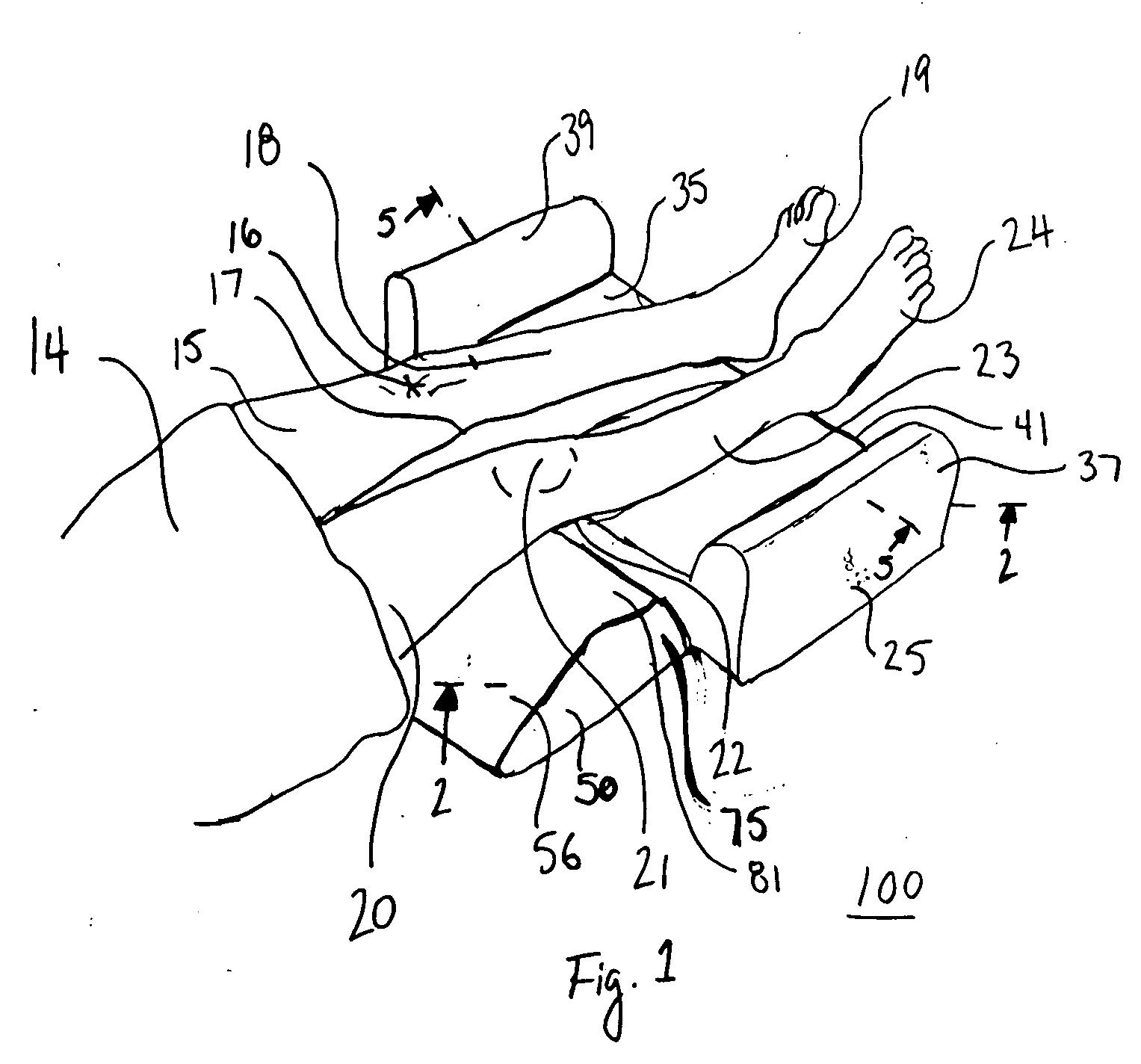Thigh support with free space for popliteal fossa
a technology of thigh support and popliteal fossa, which is applied in the direction of sofas, couches, beds, etc., can solve the problem that other limitations of related art will become apparen
- Summary
- Abstract
- Description
- Claims
- Application Information
AI Technical Summary
Benefits of technology
Problems solved by technology
Method used
Image
Examples
first embodiment
[0046]FIG. 1 is a perspective view of a first embodiment heel elevator cushion 100 in use by a patient. FIG. 1 shows a patient lying in a supine position on his or her back, in particular the torso 14, left leg comprising thigh or upper leg 15, knee 16, lower leg or calf 18, and foot 19. The popliteal fossa 17 is on the bottom side of or behind or underneath the knee. Also visible is the right leg comprising thigh or upper leg 20, knee 21, lower leg or calf 18, and foot 19. The popliteal fossa 22 is on the bottom side of or behind or underneath the knee.
[0047]The first embodiment heel elevator cushion 100 is comprised of a heel elevator support 25 connected to a connector 75, which is in turn connected to a supplemental support 50.
[0048]In use, the thighs 15 and 20 rest on the upper surface 56 of the supplemental support 50. The popliteal fossas 17 and 22 are suspended above the hemispheric bore, groove or contoured free space comprising the upper surface 81 of the connector 75. The...
second embodiment
[0060]The right connector arm 279 is a portion of the second embodiment connector 275. The connector arm is connected at one end to the heel elevator support 275 and at the other end to the supplemental support 250.
[0061]The second embodiment supplemental support 250 is shown in FIG. 4. The foundation foam 254, the upper surface 256, the viscoelastic foam layer 252, and the cover 292 which covers all surfaces of the second embodiment supplemental support are shown.
[0062]FIG. 5 is a cross-sectional view of a first embodiment heel elevator support 25 as taken along line 5-5 of FIG. 1. Visible in FIG. 5 is a foundation foam 29, viscoelastic foam layer 27 which covers the areas of the support which may contact the patient user, in particular the upper surface 35 of the support, the internal surface 32 and top 34 of left bolster 39, and internal surface 36 and top 38 of right bolster 37. A cover 90 encloses the support.
[0063]FIG. 6 is a cross-sectional view of a flat embodiment heel elev...
third embodiment
[0071]One use for the third embodiment heel elevator cushion is to elevate the lower and upper legs above the level of the patient's heart and thereby improve the patient's blood circulation while simultaneously protecting the patient's heels against heel pressure ulcers.
[0072]FIG. 11 is a cross-sectional view of a third embodiment heel elevator cushion taken along line 11-11 of FIG. 10. In this embodiment the heel elevator support 425, connector 475, and supplemental support 450 are combined in a single piece of foundation foam material 429, with the border between heel elevator support and connector indicated by dashed line 431 and the border between connector and supplemental support indicated by dashed line 433. A layer 452 of viscoelastic foam covers the upper surface 456 of the supplemental support 450; and a similar layer 427 covers the entire upper surface 435 of the heel elevator support 425. The approximately hemispheric upper surface 477 of the groove or bore or contoured...
PUM
 Login to View More
Login to View More Abstract
Description
Claims
Application Information
 Login to View More
Login to View More - R&D
- Intellectual Property
- Life Sciences
- Materials
- Tech Scout
- Unparalleled Data Quality
- Higher Quality Content
- 60% Fewer Hallucinations
Browse by: Latest US Patents, China's latest patents, Technical Efficacy Thesaurus, Application Domain, Technology Topic, Popular Technical Reports.
© 2025 PatSnap. All rights reserved.Legal|Privacy policy|Modern Slavery Act Transparency Statement|Sitemap|About US| Contact US: help@patsnap.com



